Social Sciences Geography CBSE Class 10 Agriculture LAQ
Q.1. Why is agriculture called the mainstay of Indian economy ?
Or
What is the importance of agriculture in Indian economy ?
Ans. (i) Agriculture is the mainstay of Indian economy because about 60% of our population depends directly or indirectly on agriculture.
(ii) It provides raw materials to the industries.
(iii) India earns foreign exchange by exporting agricultural products.
(iv) It contributes about 29% to the Gross Domestic Product.
(v) It provides food to over 1210.2 million population.
Q.2. What is primitive (subsistence) farming ? Write any four features of subsistence farming. [CBSE Comp. (O) 2008]
Or
Why is subsistence agriculture still practised in certain parts of the country ? Give four reasons. [CBSE Sept. 2010]
Ans. A farming in which the main production is consumed by the farmer’s household is known as subsistence farming.
Features :
(i) Old technology and traditional implements are used.
(ii) Agricultural fields are small and farmers possess scattered land holdings.
(iii) Most of the farmers are poor, and do not use fertilisers and HYV seeds.
(iv) The overall productivity is very low.
Q.3. What is intensive farming ? Write some features of intensive farming. [CBSE Sept. 2013]
Or
Why is there enormous pressure on land in Intensive Subsistence Farming ? [CBSE 2013]
Ans. Intensive farming : It is a type of farming in which the agricultural production is increased by using scientific methods and better agricultural inputs.
Features :
(i) HYV seeds and modern inputs are used to increase the production.
(ii) More than one crop is cultivated during a year.
(iii) It is practised in thickly populated areas.
(iv) The per hectare yield is very high.
Q.4. What is plantation agriculture ? Write some features of the plantation agriculture. [CBSE Sept. 2012]
Or
Describe any four characteristics of plantation agriculture. [CBSE Comp. (D) 2008]
Ans. This is a type of agriculture which involves growing and processing of a single cash crop purely meant for sale. Rubber, tea, coffee, spices, coconut and fruits are some of the * important crops which come under the category of plantation agriculture.
Features :
(i) It is a single crop farming.
(ii) It is a capital intensive farming, i.e., a huge amount of capital is required.
(iii) It needs vast estates, managerial ability, technical know-how, sophisticated machinery, fertilisers, good transport facilities and a factory for processing.
(iv) This type of agriculture has developed in areas of north-eastern India, Sub-Himalayan region, West Bengal and Nilgiri.
Q.5. What is shifting agriculture ? Why shifting agriculture is being discouraged ?
Ans. It is that type of agriculture in which farmers clear the forest land and use it for growing crops. The crops are grown for 2 to 3 years, and when the fertility of the soil decreases, the farmer shifts to a new land. Dry paddy, maize, millets and vegetables are the crops commonly grown in this type of farming.
It is being discouraged because :
(i) This leads to deforestation.
(ii) The per hectare yield is very low.
Q.6. Explain the favourable geographical conditions required for the production of rice. Also mention the major rice producing states of India. [CBSE Sept. 2010, 2011, 2012, 2013]
Ans. (i) Temperature : It is a kharif crop which requires high temperature, and high humidity. This means monthly temperature of about 25°C with minor variation during the sowing, growing and harvesting season, is suitable for the growth of the plant.
(ii) Rainfall : Rice needs abundant rainfall, i.e., more than 100 cm. It can grow in areas with less rainfall, but with assured irrigation. Rice is grown in Punjab and Haryana with the help of irrigation.
(iii) Soil : Rice can grow in a variety of soils including silts, loams and gravels, but it is grown best in alluvial soil with a sub-soil of impervious clay. Areas of production : Rice is cultivated in almost all the states of India, but most of its cultivation is concentrated in the river valleys, deltas of rivers and the coastal plains.
The main rice producing states are West Bengal, Andhra Pradesh, Uttar Pradesh, Bihar, Punjab, Odisha, Karnataka, Assam and Maharashtra.
Q.7. What type of climate is required for the cultivation of wheat ? Name any four important wheat producing states of India. [CBSE Sept. 2012]
Ans. (i) Temperature : Cool and moist weather during growth, and warm and dry climate during ripening is needed.
(ii) Rainfall : 50-75 cm rainfall is required. Rainfall is necessary and beneficial, 15 days after sowing, and 15 days before ripening. A few light winter showers or assured irrigation ensures a bumper harvest.
(iii) Soil : Light domat (loamy) soil is required. It can also be grown in black soil. Important producers : Punjab, Haryana, western Uttar Pradesh and Madhya Pradesh are the main producers of wheat.
Q.8. Describe three geographical requirements for maize cultivation – temperature, rainfall and soil. Name three maize producing states of India. [CBSE Sept. 2010]
Ans. (i) Temperature : It grows well under temperature between 21°C and 27°C.
(ii) Rainfall : It grows well in areas of 50¬100 cm of rain, and in areas of less rain, if grown under irrigation.
(iii) Soil : It requires well drained alluvial fertile soil or red loams free from coarse materials. Important produces : Karnataka, Uttar Pradesh, Bihar and Andhra Pradesh are the leading producers.
Q.9. Describe the temperature and climatic conditions required for the cultivation of sugarcane. Name two leading producers. [CBSE Comp. 2008,09(D), 2010(0)]
Or
What geographical conditions are required for the cultivation of sugarcane ? Name two largest producing states of sugarcane. [CBSE Sept. 2010]
Ans. (i) Temperature : Sugarcane needs hot and humid climate with temperature ranging between 21°C to 27°C. Very high temperature is harmful for its growth, while low temperature slows its growth. It cannot withstand frost. Cool temperature is needed at the time of ripening.
(ii) Rainfall : It grows best in areas receiving 75 cm to 100 cm of rainfall. Too heavy rainfall results in low sugar content.
(iii) Soil : Sugarcane grows on well-drained fertile soil. It can grow on a variety of soils including black, alluvial, loamy and reddish loam.
Sugarcane :
But the best soil is the alluuial soil of the Ganga Plain and the black soil of southern India. Sugarcane exhausts the fertility of the soil. Hence, the use of manure is essential to ensure high yields.
Areas of Production :
Uttar Pradesh is the largest producer of sugarcane. The other states in the Ganga-Plain are Bihar, Punjab and Haryana.
Q.10. Name the most important beverage crop of India. Describe the suitable climatic conditions required for its growth. Also mention the major states producing that crop. [CBSE 2010(0)]
Or
Describe any three geographical conditions required for tea cultivation. Name any two producing states of tea. [CBSE Sept. 2010, 2012]
Or
Name the important beverage crop introduced by the British in India. Explain the geographical conditions needed for its cultivation. Write any two important states where it is grown. [CBSE 2013]
Or
Describe any four ‘ geographical conditions required for the growth of tea. Mention the two major tea producing states of South India. [CBSE 2012]
Ans. Tea is the most important beverage crop of India.
Climatic conditions :
(i) Temperature : The tea plant grows well in tropical and sub tropical climate. Tea bushes require warm and moist, frost-free climate all through the year. Tea bushes need temperature of more than 25°C.
(ii) Rainfall : Tea plant needs heavy rainfall ranging between 150 cm to 250 cm. The rainfall should be well distributed throughout the year.
(iii) Soil : The plant requires a light loamy soil. The soil should be rich in humus and iron content. Tea is a soil exhausting crop, so frequent use of chemical fertilisers and manure is essential.
Producers :
Major tea-producing states are Assam, West Bengal, (Hills of Darjeeling and Jalpaiguri Districts), Tamil Nadu and Kerala. Apart from these, Himachal Pradesh, Uttarakhand, Meghalaya, Andhra Pradesh and Tripura are also tea producing states in the country.
Q.11. Explain the favourable climatic conditions required for the production of rubber. Also mention the states producing rubber. [CBSE Comp. (D) 2008, 2008 (F), Sept. 2010, 2011, 2012]
Ans. (i) Temperature : It is a tree of the tropical forests, and requires a constant high temperature above 25°C. Thus, the rubber tree cannot be grown at high altitudes.
(ii) Rainfall : It needs heavy and well distributed rainfall throughout the year. The plant needs rainfall more than 200 cm.
(iii) Soil: The plant requires alluvial or laterite soil. Areas of Production :
India ranks fifth among the world’s natural rubber producers. The state of Kerala is the largest producer of rubber in India. Kerala accounts for about 91% of the total area under rubber plantation. Tamil Nadu, Karnataka and The Andaman and Nicobar islands including the Garo Hills of the Himalayas are the other producers.
Q.12. Explain the climatic conditions required for the production of cotton. Also mention the major cotton producing states of India.
Ans. (i) Temperature : Cotton needs a warm climate. Summer temperatures of 21°C to 27°C, and abundant sunshine is necessary during the growth of the plant. A long growing period of atleast 210 frostfree days is also necessary for the plant to mature.
(ii) Rainfall : Moderate to light rainfall is adequate for cotton cultivation. Rainfall ranging between 50 cm to 80 cm is adequate. The crop can be successfully grown in areas of low rainfall with the help of irrigation.
(iii) Soil : Cotton can be grown on a variety of soils but the black cotton soil of the Deccan Plateau which has the ability to retain moisture is most suitable. It also grows well in alluvial soils of the Satluj-Ganga Plain.
Areas of Production :
The leading cotton producing states are Gujarat, Maharashtra, Andhra Pradesh, Punjab, Haryana, Karnataka, Tamil Nadu and Madhya Pradesh. Punjab and Haryana grow the long staple variety.
Q.13. Which crop is known as the “golden fibre” ? Explain two geographical conditions essential for the cultivation of this crop. Mention any four uses. [CBSE 2012]
Or
What is known as ‘golden fibre’? Where is it grown in India and why ? Describe various uses of this fibre. [CBSE 2012]
Ans. (1) Jute is called golden fibre.
(2) Geographical conditions for its cultivation are as follows :
(i) Jute grows well in well-drained fertile soils of the flood plains where the soil is renewed every year.
(ii) High temperature is required during the time of growth.
(3) It grows well on well-drained fertile soils in the flood plains.
(4) Therefore, it is grown in West Bengal, Bihar, Assam, Odisha and Meghalaya.
Uses : It can be used to manufacture gunny bags, mats, ropes, yam, carpets and other artifacts.
Q.14. Differentiate between the commercial agriculture and the subsistence agriculture. [CBSE Sept. 2010, 2011, 2012, 2013]
Or
Write any four characteristics of commercial Agriculture? [CBSE Sept. 2011]
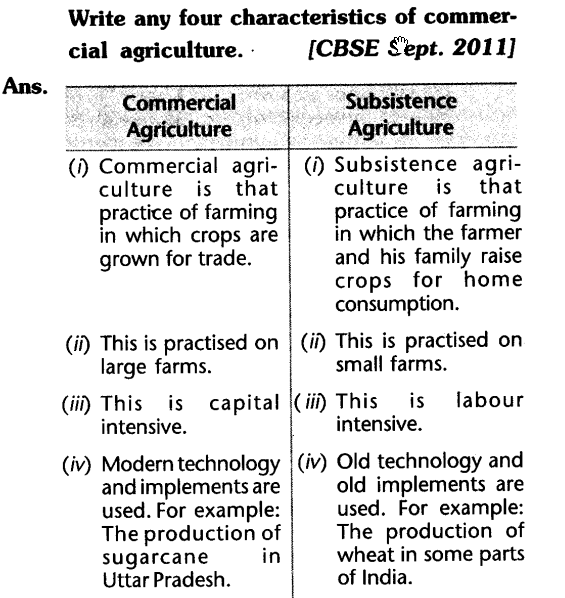
Q.15. Distinguish between :
(i) Dry farming and wet farming.
Or
Write any two features of dry farming/wet farming.
(ii) Rabi and kharif crop.
(iii) Tea and coffee. [CBSE Sept. 2010]
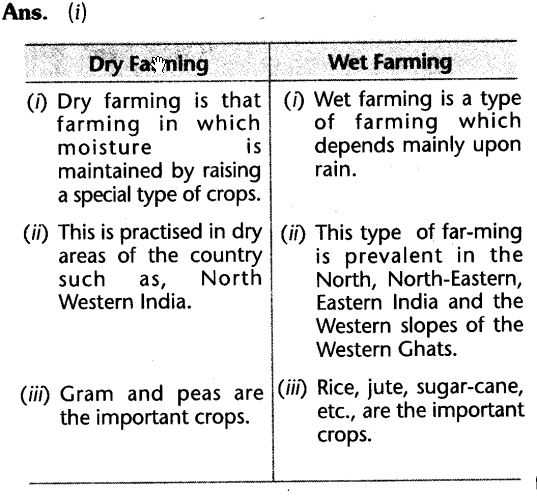
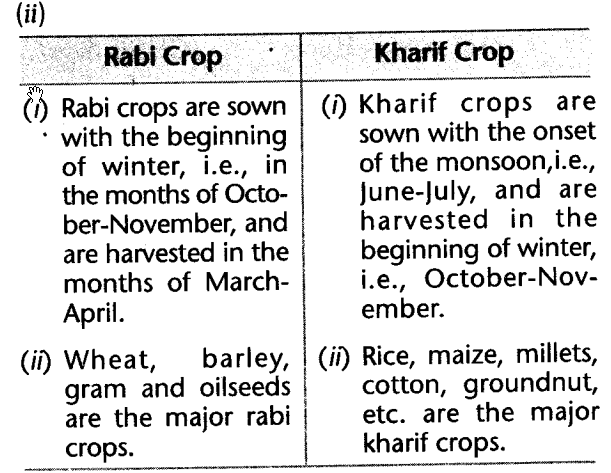
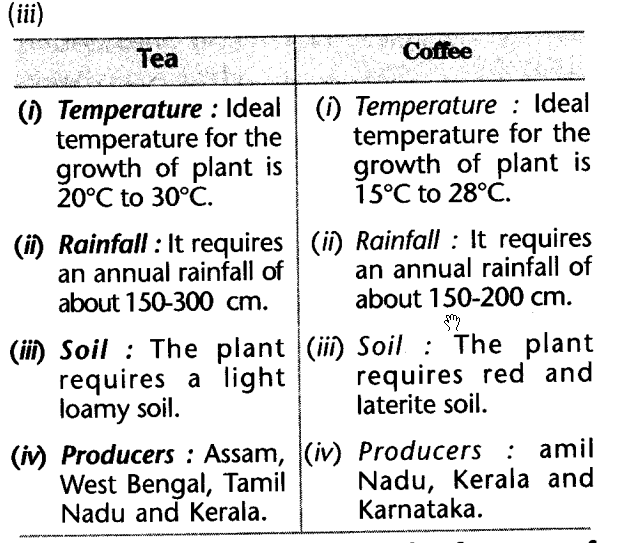
Q.16. Which are the two staple food crops of India ? Compare and contrast the climatic and soil requirements of the two. [CBSE Sept. 2013]
Ans. Rice and wheat are two staple food crops of India
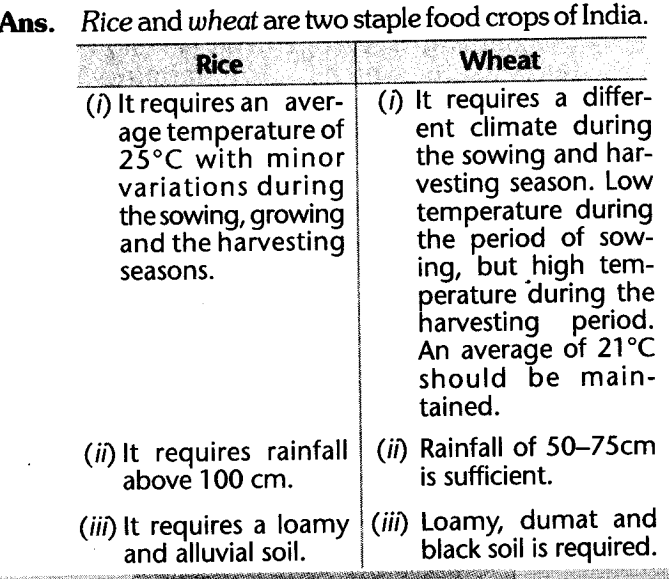
Q.17. Name any four oilseeds produced in India. What is their economic importance ?
Or
Name any four oilseeds produced in India. Explain the importance of oilseeds in our day to day life. [CBSE 2012]
Ans. Main oilseeds produced in India are :
(i) Groundnut (ii) Mustard
(iii) Coconut (iv) Sesamum
Economic importance of oilseeds :
(i) Most of these are edible, and used as a cooking medium in the form of oil.
(ii) Extracted oil is also used as raw material for manufacturing large number of items like paints, varnishes, hydrogenated oil, soaps, perfumes, lubricants, etc.
(iii) Oil cake which is the by product, obtained after the extraction of oil from oilseeds is an excellent cattle feed.
(iv) Oil cake is also used as a fertilisers.
Q.18. Which states are the leading producers of the following horticultural crops ?
(i) Mangoes
(ii) Bananas
(iii) Grapes
(iv) Apples and Apricots
Ans. (i) Mangoes : Maharashtra, Andhra Pradesh, Uttar Pradesh and West Bengal.
(ii) Bananas : Kerala, Mizoram, Maharashtra and Tamil Nadu.
(iii) Grapes : Andhra Pradesh and Maharashtra.
(iv) Apples and Apricots : Jammu and Kashmir and Himachal Pradesh.
Q.19. Look at the given picture carefully and answer the questions that follow : [CBSE 2009 (O)]
(i) Name the crop shown in the picture.
(ii) State the climatic conditions required for the cultivation of this crop.
(iii) Name the two major regions of growing this crop.
Ans. (i) Rice.
(ii) Refer Q.No. 6, Long Answer Type Questions.
(iii) Refer Q.No. 6, Long Answer Type Questions.
Q.20. “Today Indian farmers are facing a big challenge from international competition.” What are the various factors responsible for this situation ?
Or
Why is the growth rate in agriculture decelerating ? [CBSE 2010(F)]
Ans. (i) The Indian government is going ahead with reduction in the public investment in the agriculture sector particularly in irrigation, power, rural roads, market and mechanisation.
(ii) Subsidy on fertilisers is decreased leading to increase in the cost of production.
(iii) Reduction in import duties on agricultural products have proved detrimental to agriculture in the country.
(iv) Farmers are withdrawing their investment from agriculture causing a downfall in the employment in agriculture.
Q.21. Name any three features of Indian agriculture. [CBSE 2013]
Or
What are the factors responsible for the backwardness of Indian agriculture ?
Or
Describe any four features of agriculture in India. [CBSE Sept. 2010]
Ans. (I) Over dependence on monsoon : Major portion of the cropped area still depends upon monsoons for irrigation. Only one- third of the cropped area is under assured irrigation.
(ii) Subsistence agriculture : (For this, refer Question No. 2, Long Answer Type Questions)
(iii) Small and scattered land holding : Due to the increasing population, the per hectare availability of land is very low. The Jand holding is also scattered.
(iv) Lack of inputs : Most of the farmers are poor so they do not use fertilisers and high yielding varieties of seeds.
Q.22. Describe various technological and institutional reforms which led to the Green and White Revolution in India. [CBSE Sept. 2012]
Ans. No description regarding white Revolution. Green Revolution means revolution in the field of agricultural production due to the introduction of various technological and institutional reforms.
Factors responsible :
(i) Agriculture was given the top priority in Five Year Plans.
(ii) The development of HYV seeds of wheat in the early 60s, and those of rice in 70s laid the foundation of the Green Revolution in India.
(iii) Several schemes for irrigation were undertaken, and arid and semi-arid areas were brought under cultivation.
(iv) Collectivisation, consolidation of holdings, abolition of the Zamindari system, etc., were given top priority to bring about institutional reforms in the country after independence.
(v) Cropped insurance scheme was launched by the government to protect the farmers against losses caused by crop failure on account of natural calamities like drought, flood, hailstorm, cyclone, fire, etc.
(vi) Easy availability of capital or investment, input through a well knit network of rural banking and small scale co-operative societies with low interest rates were other facilities provided to the farmers for the modernisation of agriculture.
Q.23. Compare the geographical conditions required for the production of cotton and jute. [CBSE 2014]
Ans. The following geographical conditions are required for the production of cotton and jute :
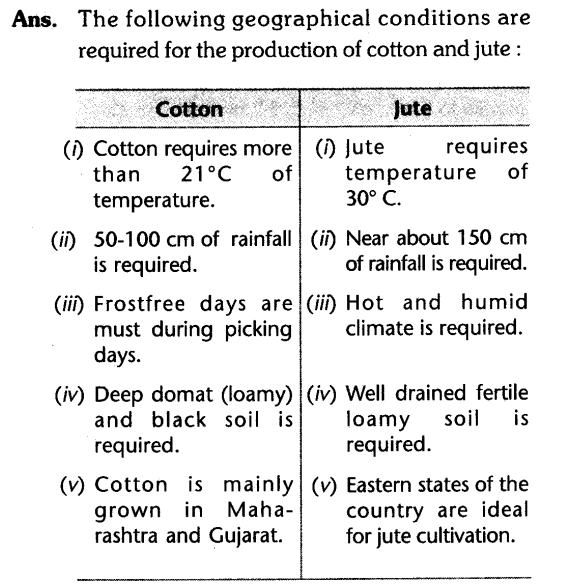
Q.24. How is the government helping the Indian farmers in increasing their agricultural production ? Explain any four points.
Or
Describe any four reforms brought in the Indian agriculture after independence through the efforts of the Indian government. [CBSE 2010(F), Sept. 2010]
Or
What initiatives have been taken by government to ensure an increase in agricultural production ? [CBSE Sept. 2011]
Ans. (i) Institutional Reforms : To increase production in agriculture, the government has introduced some institutional measures which include collectivisation, consolidation of holding, cooperation and abolition of Zamindari system.
(ii) Comprehensive Land Development Programme : In the 1980s and 1990s, a comprehensive land development programme was initiated, which included both institutional and technical reforms. Provision for crop insurance against drought, flood, cyclone, fire and disease, establishment of Grameen banks, cooperative societies and banks for providing loan facilities to the farmers at lower rates of interest were some important steps in this direction.
(iii) Subsidies : The government is providing huge subsidies on the agricultural inputs. At present, maximum subsidy is being given on fertilizers.
(iv) HYV Seeds and Agriculture Universities : In order to enhance production, the government is providing HYV seeds to the farmers. Special seminars are also being held. Many new agricultural universities have been established.
(v) Public Procurement System and Agriculture Price Commission : Agriculture Price Commission has been set up which declares the prices of agricultural products in advance so that the farmers may know what they are going to get for their agricultural products. Government agencies like the F.C.I. (Food Corporation of India) purchase the agricultural products from the farmers.
(vi) Crop Insurance and Agricultural Finance : As we are aware that the Indian agriculture mainly depends on nature, so high risk crops are also being insured. The government has established special banks like the NABARD to provide agricultural loans to farmers.

